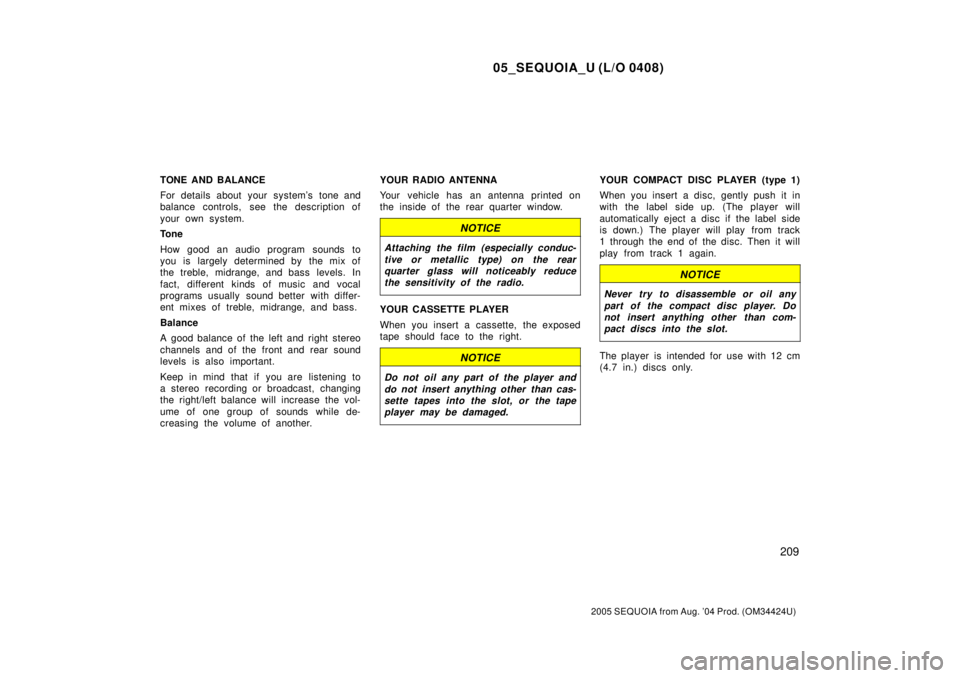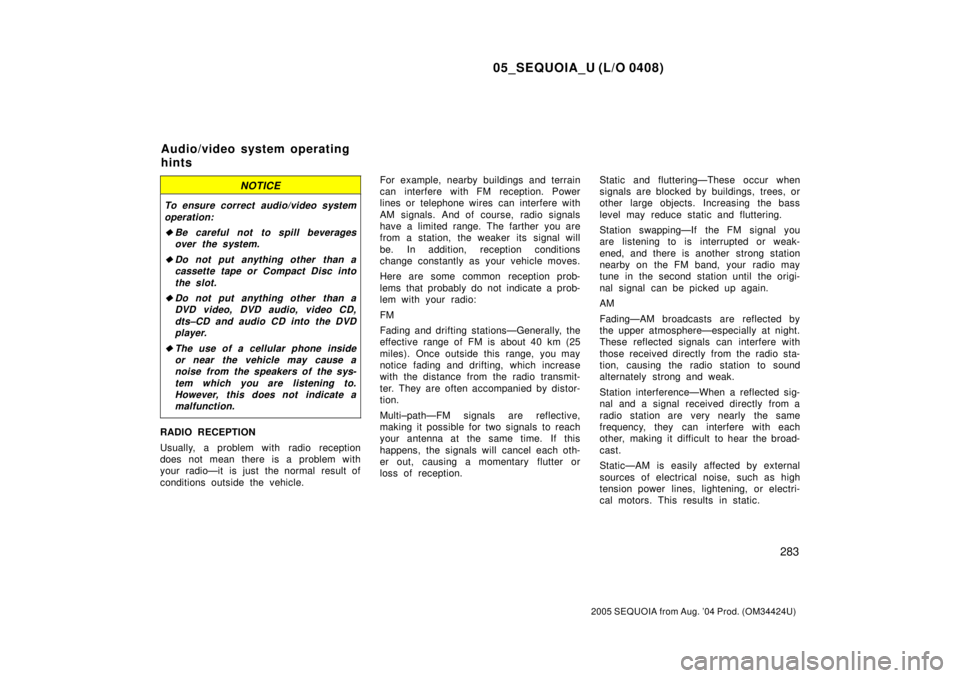Page 2435 of 4323

± DIAGNOSTICSNAVIGATION SYSTEM
DI±2233
2427 Author�: Date�:
2005 SEQUOIA (RM1146U)
Abnormal noise occurs
INSPECTION PROCEDURE
1 Check speaker installation
CHECK:
Check if each speaker is securely installed.
OK:
Each speaker is securely installed.
HINT:
The radio is equipped with a noise prevention system that blocks only excessively loud noise. If loud noise
occurs, check that all wiring is proper and that the antenna installation part ground and noise±prevention
equipment are installed.
Conditions under which noise occursNoise type
Noise increases when the accelerator pedal is depressed, but stops when
the engine is stopped.Generator noise
Noise occurs during A/C or heater operation.Blower motor noise
Noise occurs when the vehicle accelerates rapidly on an unpaved road or
after the ignition switch is turned on.Fuel pump noise
Noise occurs when the horn switch is pressed and released or when pressed
and held.Horn noise
Quiet noise is occurs while the engine is running, but stops when the engine
is stopped.Ignition noise
Noise occurs synchronously with the blink of the turn signal.Flasher noise
Noise occurs during window washer operation.Washer noise
Noise occurs while the engine is running, and continues even after the engine
is stopped.Water temperature sensor noise
Noise occurs during wiper operation.Wiper noise
Noise occurs when the brake pedal is depressed.Stop light switch noise
Others.Static electricity stored on the vehicle
HINT:
�Identify the condition under which the noise occurs, and check the noise filter on the relevant part.
�First ensure that the noise is not coming from outside. Failure to do so makes noise source detection
difficult and may lead to a misdiagnosis.
�Noise should be removed in descending order of loudness.
NG Install it properly.
OK
Identification of noise source (See page DI±2174).
DIDCO±01
Page 2493 of 4323
I28480
Combination Meter
SPD G±O 25
C53
R29 J17
J/C
BRadio and Navigation Assy
BG±O
± DIAGNOSTICSNAVIGATION SYSTEM
DI±2291
2485 Author�: Date�:
2005 SEQUOIA (RM1146U)
Speed signal circuit
CIRCUIT DESCRIPTION
The navigation ECU (built in the radio and navigation assy) receives a vehicle speed signal from the com-
bination meter assy and information about the GPS antenna, and then adjusts vehicle position.
HINT:
�A voltage of 12 V or 5 V is output from each ECU and then input to the combination meter. The signal
is changed to a pulse signal at the transistor in the combination meter. Each ECU controls the respec-
tive system based on the pulse signal.
�If a short occurs in an ECU, all systems in the speed signal circuit will not operate normally.
WIRING DIAGRAM
DIDDP±01
Page 2496 of 4323
I28481
Radio and Navigation Assy
P1
Park/Neutral Position Switch
Instrument Panel J/BREV
IG4J/C
J51 J52
From Ignition
SwitchR29
IPORAD No. 2
1D 1CRB
RL L±R B±Y5 FH
L±R B±Y
L±R7
1
8
6 9
1 2 DI±2294
± DIAGNOSTICSNAVIGATION SYSTEM
2488 Author�: Date�:
2005 SEQUOIA (RM1146U)
Reverse signal circuit
CIRCUIT DESCRIPTION
The radio and navigation assy receives the reverse signal from the park/neutral position switch and informa-
tion about the GPS antenna, and then adjusts the vehicle position.
WIRING DIAGRAM
DIDDQ±01
Page 4068 of 4323

05_SEQUOIA_U (L/O 0408)
209
2005 SEQUOIA from Aug. '04 Prod. (OM34424U)
TONE AND BALANCE
For details about your system's tone and
balance controls, see the description of
your own system.
Tone
How good an audio program sounds to
you is largely determined by the mix of
the treble, midrange, and bass levels. In
fact, different kinds of music and vocal
programs usually sound better with differ-
ent mixes of treble, midrange, and bass.
Balance
A good balance of the left and right stereo
channels and of the front and rear sound
levels is also important.
Keep in mind that if you are listening to
a stereo recording or broadcast, changing
the right/left balance will increase the vol-
ume of one group of sounds while de-
creasing the volume of another.YOUR RADIO ANTENNA
Your vehicle has an antenna printed on
the inside of the rear quarter window.
NOTICE
Attaching the film (especially conduc-
tive or metallic type) on the rear
quarter glass will noticeably reduce
the sensitivity of the radio.
YOUR CASSETTE PLAYER
When you insert a cassette, the exposed
tape should face to the right.
NOTICE
Do not oil any part of the player and
do not insert anything other than cas-
sette tapes into the slot, or the tape
player may be damaged.
YOUR COMPACT DISC PLAYER (type 1)
When you insert a disc, gently push it in
with the label side up. (The player will
automatically eject a disc if the label side
is down.) The player will play from track
1 through the end of the disc. Then it will
play from track 1 again.
NOTICE
Never try to disassemble or oil any
part of the compact disc player. Do
not insert anything other than com-
pact discs into the slot.
The player is intended for use with 12 cm
(4.7 in.) discs only.
Page 4142 of 4323

05_SEQUOIA_U (L/O 0408)
283
2005 SEQUOIA from Aug. '04 Prod. (OM34424U)
NOTICE
To ensure correct audio/video system
operation:
�Be careful not to spill beverages
over the system.
�Do not put anything other than a
cassette tape or Compact Disc into
the slot.
�Do not put anything other than a
DVD video, DVD audio, video CD,
dts±CD and audio CD into the DVD
player.
�The use of a cellular phone inside
or near the vehicle may cause a
noise from the speakers of the sys-
tem which you are listening to.
However, this does not indicate a
malfunction.
RADIO RECEPTION
Usually, a problem with radio reception
does not mean there is a problem with
your radioÐit is just the normal result of
conditions outside the vehicle.For example, nearby buildings and terrain
can interfere with FM reception. Power
lines or telephone wires can interfere with
AM signals. And of course, radio signals
have a limited range. The farther you are
from a station, the weaker its signal will
be. In addition, reception conditions
change constantly as your vehicle moves.
Here are some common reception prob-
lems that probably do not indicate a prob-
lem with your radio:
FM
Fading and drifting stationsÐGenerally, the
effective range of FM is about 40 km (25
miles). Once outside this range, you may
notice fading and drifting, which increase
with the distance from the radio transmit-
ter. They are often accompanied by distor-
tion.
Multi±pathÐFM signals are reflective,
making it possible for two signals to reach
your antenna at the same time. If this
happens, the signals will cancel each oth-
er out, causing a momentary flutter or
loss of reception.Static and flutteringÐThese occur when
signals are blocked by buildings, trees, or
other large objects. Increasing the bass
level may reduce static and fluttering.
Station swappingÐIf the FM signal you
are listening to is interrupted or weak-
ened, and there is another strong station
nearby on the FM band, your radio may
tune in the second station until the origi-
nal signal can be picked up again.
AM
FadingÐAM broadcasts are reflected by
the upper atmosphereÐespecially at night.
These reflected signals can interfere with
those received directly from the radio sta-
tion, causing the radio station to sound
alternately strong and weak.
Station interferenceÐWhen a reflected sig-
nal and a signal received directly from a
radio station are very nearly the same
frequency, they can interfere with each
other, making it difficult to hear the broad-
cast.
StaticÐAM is easily affected by external
sources of electrical noise, such as high
tension power lines, lightening, or electri-
cal motors. This results in static.
Audio/video system operating
hints
Page:
< prev 1-8 9-16 17-24